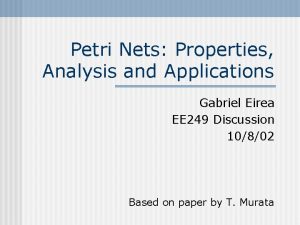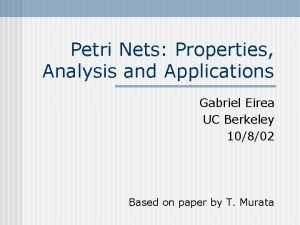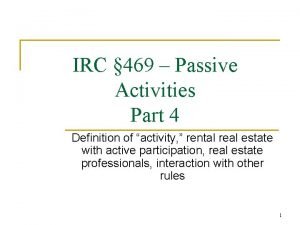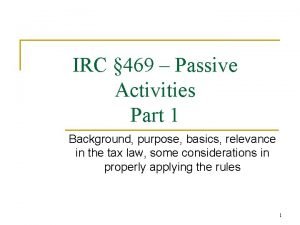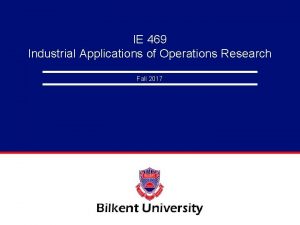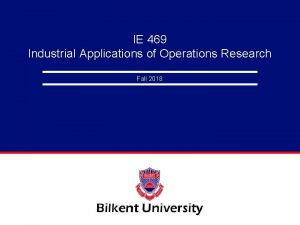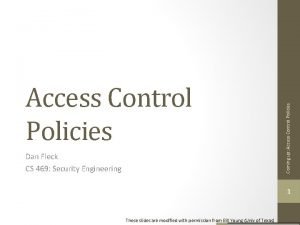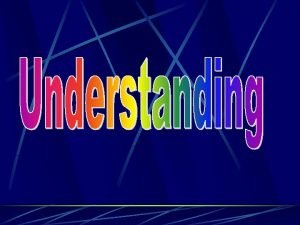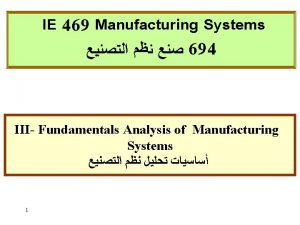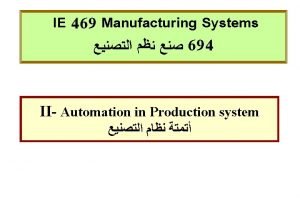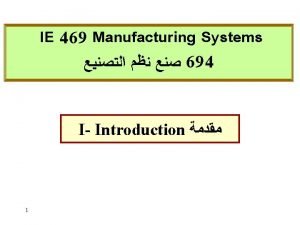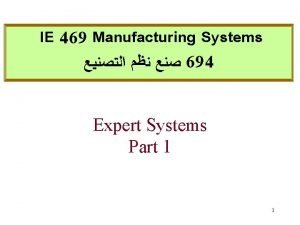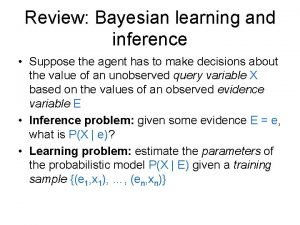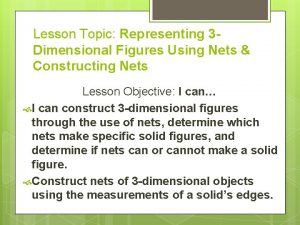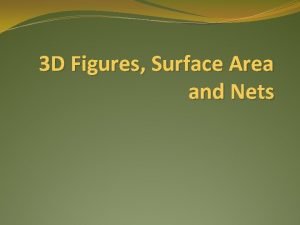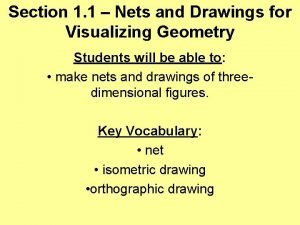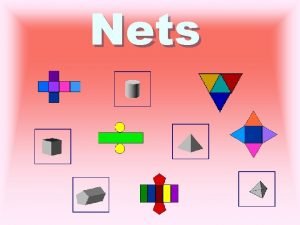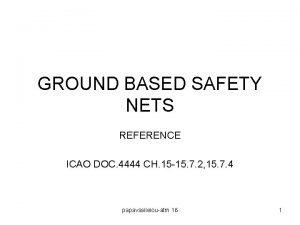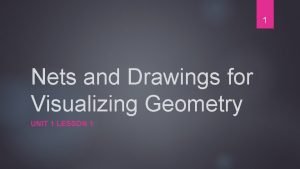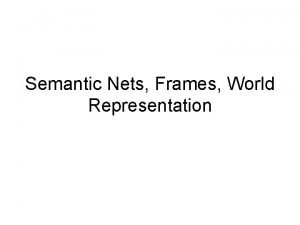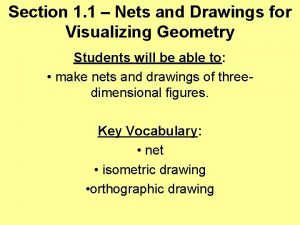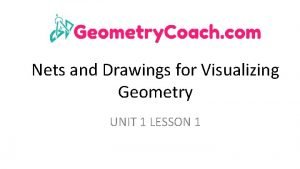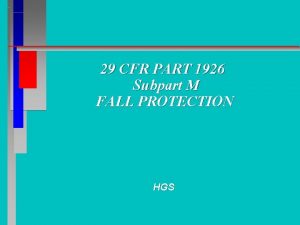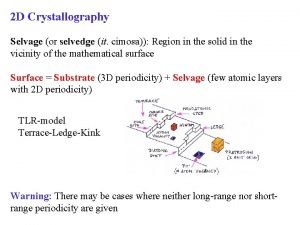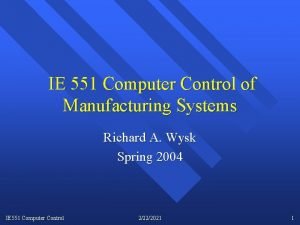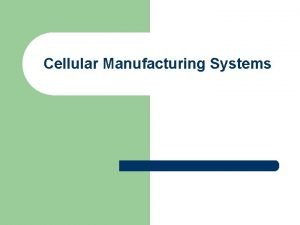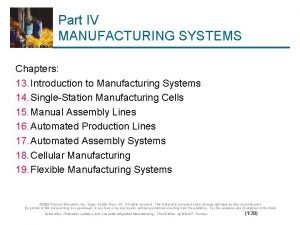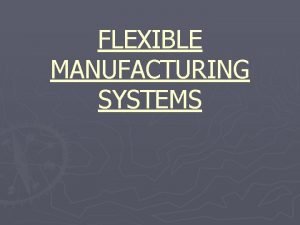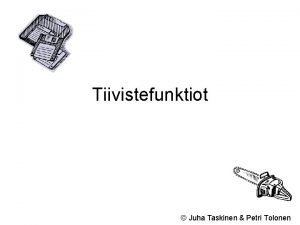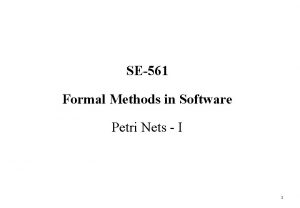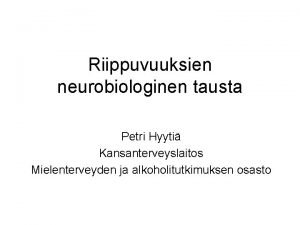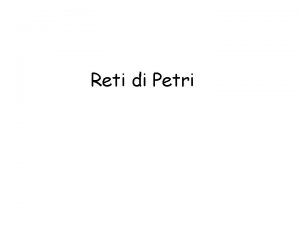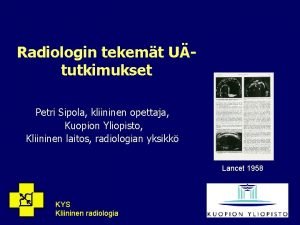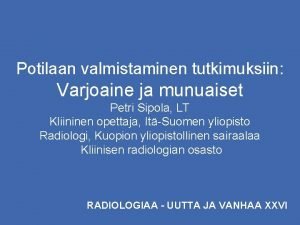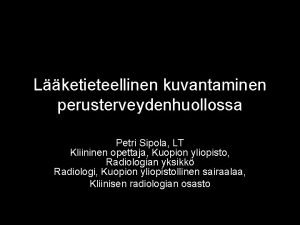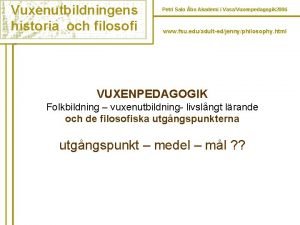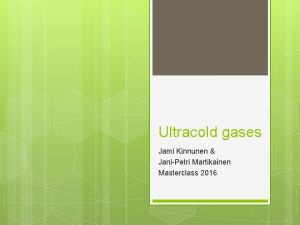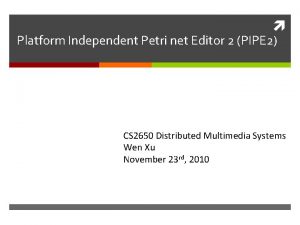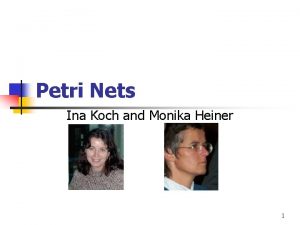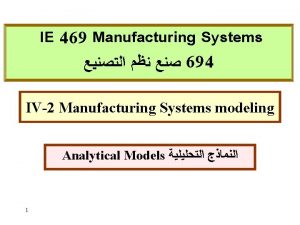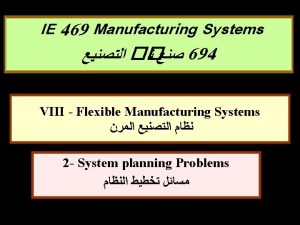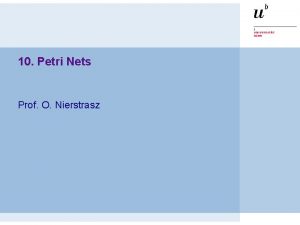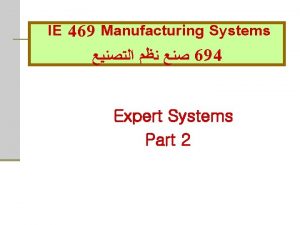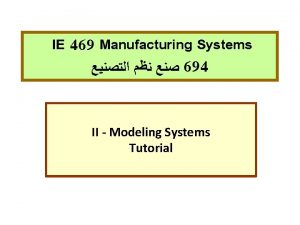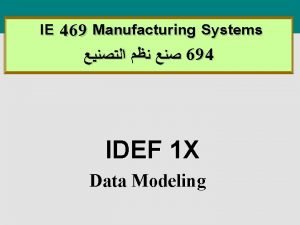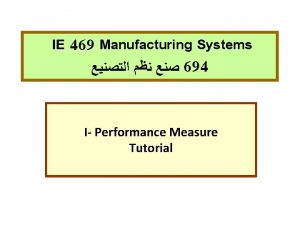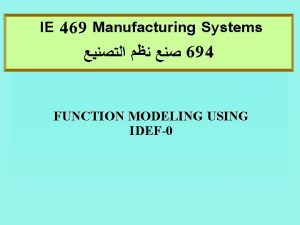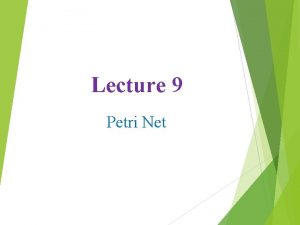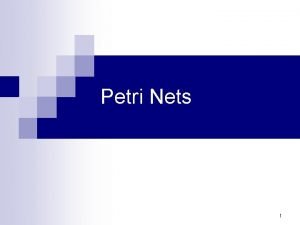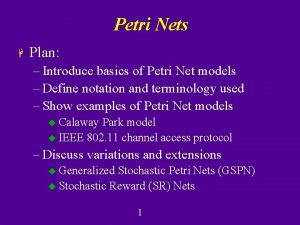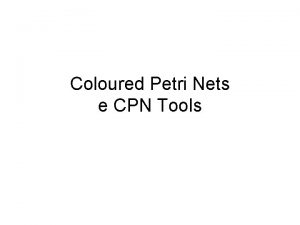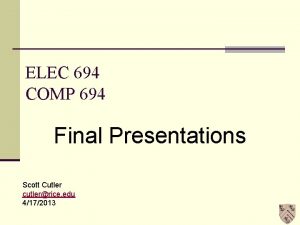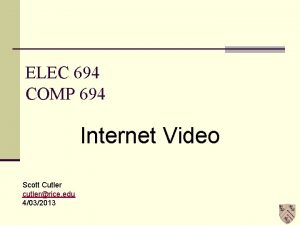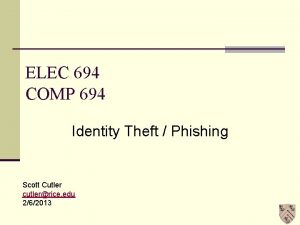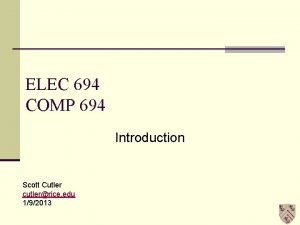IE 469 Manufacturing Systems 694 Petri Nets 1































































- Slides: 63

IE 469 Manufacturing Systems ﺼﻨﻊ ﻨﻈﻢ ﺍﻟﺘﺼﻨﻴﻊ 694 Petri Nets 1

Outline • Petri nets – Introduction – Examples – Properties – Analysis techniques 2

Petri net models and graphical representation A Petri net (PN) is defined as a directed bipartite graph having a structure, C, and a marking, M. we use the definition C = (P, T, I, O), where: P = a set of places. P = {pl, p 2, p 3, . . . pn} T = a set of transitions. T = {t 1, t 2, t 3. . . tm} I = a mapping from places to transitions. (PXT) N O= a mapping from transitions to places. (PXT) N Each of these concepts has a graphical representation. The place is represented by a circle, the transition by a bar, and the input and output mapping by a set of directed arcs. 3

In this illustration there are four places, P = {p 1, p 2, p 3, p 4}, and three transitions, T = {t 1, t 2, t 3}. There also eight directed arcs which define I and O • Tokens: black dots p 2 t 2 p 1 2 t 1 p 4 3 t 3 p 3 4

Petri net, unmarked and marked. mappings can be described in matrix form as follows: 5

Petri Net • A PN (N, M 0) is a Petri Net Graph N – places: represent distributed state by holding tokens (Activities) • marking (state) M is an n-vector (m 1, m 2, m 3…), where mi is the nonnegative number of tokens in place pi. • initial marking (M 0) is initial state – transitions: represent actions/events • enabled transition: enough tokens in predecessors • firing transition: modifies marking • …and an initial marking M 0. p 1 p 2 t 1 2 p 4 3 Places/Transition: conditions/events t 3 p 3 6

Transition firing rule • A marking is changed according to the following rules: – A transition is enabled if there are enough tokens in each input place – An enabled transition may or may not fire – The firing of a transition modifies marking by consuming tokens from the input places and producing tokens in the output places 2 2 3 7

Concurrency, causality, choice t 1 t 2 t 3 t 5 t 4 t 6 8

Concurrency, causality, choice t 1 Concurrency t 2 t 3 t 5 t 4 t 6 9

Concurrency, causality, choice t 1 t 2 Causality, sequencing t 3 t 5 t 4 t 6 10

Concurrency, causality, choice t 1 t 2 t 3 t 5 Choice, conflict t 4 t 6 11

Concurrency, causality, choice t 1 t 2 t 3 t 5 Choice, conflict t 4 t 6 12

Example 13

Producer-Consumer Problem Produce Buffer Consume 14

Producer-Consumer Problem Produce Buffer Consume 15

Producer-Consumer Problem Produce Buffer Consume 16

Producer-Consumer Problem Produce Buffer Consume 17

Producer-Consumer Problem Produce Buffer Consume 18

Producer-Consumer Problem Produce Buffer Consume 19

Producer-Consumer Problem Produce Buffer Consume 20

Producer-Consumer Problem Produce Buffer Consume 21

Producer-Consumer Problem Produce Buffer Consume 22

Producer-Consumer Problem Produce Buffer Consume 23

Producer-Consumer Problem Produce Buffer Consume 24

Producer-Consumer Problem Produce Buffer Consume 25

Producer-Consumer Problem Produce Buffer Consume 26

Producer-Consumer Problem Produce Buffer Consume 27

Producer-Consumer with priority A Consumer B can consume only if buffer A is empty Inhibitor arcs B 28

PN properties • Behavioral: depend on the initial marking (most interesting) – – – Reachability Boundedness Schedulability Liveness Conservation • Structural: do not depend on the initial marking (often too restrictive) – Consistency – Structural boundedness 29

Reachability • Marking M is reachable from marking M 0 if there exists a sequence of firings s = M 0 t 1 M 1 t 2 M 2… M that transforms M 0 to M. • The reachability problem is decidable. p 2 p 1 t 2 t 1 p 4 p 3 M 0 = (1, 0, 1, 0) M = (1, 1, 0, 0) t 3 M 0 = (1, 0, 1, 0) t 3 M 1 = (1, 0, 0, 1) t 2 M = (1, 1, 0, 0) 30

When the transition tj fires it results in a new marking M’, (by removing I(pi, tj) tokens from each of its input places and adding O(pi, tj) tokens to each of its output places. Then, M’ is reachable from M as: M’(pi)=M(pi)+O(pi, tj)-I(pi, tj) Example: The following figure shows the change in state from Mk. T=[u(t 1), to M by firing t 1. Let u be a firing vector, where u 1 k u(t 2), u(t 3)]. Then Mk = Mk-1+Ouk-Iuk =Mk-1+Auk 31

32

Petri net invariants An invariant of a PN depends on its topology. 1. P-invariant. 2. T-invariant. If there exists a set of non-negative integers x such that x. TA=0, then x is called a P-invariant of the PN. Let x be a weighting vector of places x=[w 1, w 2, w 3, …wn]. There are (n-r) minimal P-invariants. n= number of places. r= the rank of A. 33

which has the following solutions: 34

T-invariant A vector y of non-negative integers is a T-invariant if there exists a marking M and a firing sequence back to M whose firing count vector is y. A T-invariant is a solution to the equation Ay=0. Let y be a vector y=[u 1, u 2, u 3, …. . um]. Which yields the Tinvariant y. T=(1, 1, 1). y defines the number of times each transition must be fire in one complete cycle from M 0 back to it self. In general there are (m-r) T-invariants. m= number of transitions. 35

Liveness • Liveness: from any marking any transition can become fireable – Liveness implies deadlock freedom, not viceversa Not live 36

Liveness • Liveness: from any marking any transition can become fireable – Liveness implies deadlock freedom, not viceversa Not live 37

Liveness • Liveness: from any marking any transition can become fireable – Liveness implies deadlock freedom, not viceversa Deadlock-free 38

Liveness • Liveness: from any marking any transition can become fireable – Liveness implies deadlock freedom, not viceversa Deadlock-free 39

Boundedness • Boundedness: the number of tokens in any place cannot grow indefinitely – (1 -bounded also called safe) – Application: places represent buffers and registers (check there is no overflow) Unbounded 40

Boundedness • Boundedness: the number of tokens in any place cannot grow indefinitely – (1 -bounded also called safe) – Application: places represent buffers and registers (check there is no overflow) Unbounded 41

Boundedness • Boundedness: the number of tokens in any place cannot grow indefinitely – (1 -bounded also called safe) – Application: places represent buffers and registers (check there is no overflow) Unbounded 42

Boundedness • Boundedness: the number of tokens in any place cannot grow indefinitely – (1 -bounded also called safe) – Application: places represent buffers and registers (check there is no overflow) Unbounded 43

Boundedness • Boundedness: the number of tokens in any place cannot grow indefinitely – (1 -bounded also called safe) – Application: places represent buffers and registers (check there is no overflow) Unbounded 44

Conservation • Conservation: the total number of tokens in the net is constant Not conservative 45

Conservation • Conservation: the total number of tokens in the net is constant Not conservative 46

Conservation • Conservation: the total number of tokens in the net is constant Conservative 2 2 47

Analysis techniques • Structural analysis techniques – Incidence matrix – T- and P- Invariants • State Space Analysis techniques – Coverability Tree – Reachability Graph 48

Incidence Matrix t 2 p 1 t 1 p 2 p 3 t 1 t 3 -1 A= 1 0 t 2 t 3 0 1 -1 0 p 1 -1 p 2 1 p 3 • Necessary condition for marking M to be reachable from initial marking M 0: there exists firing vector v s. t. : M = M 0 + A v 49

State equations • E. g. reachability of M =|0 0 1|T from M 0 = |1 0 0|T p 1 t 1 p 2 t 2 p 3 -1 A= 1 0 0 1 -1 0 -1 1 t 3 1 v 1 = 0 1 -1 0 = 0 + 1 1 0 0 0 1 -1 0 -1 1 1 0 1 50

Reachability x. TM’ = x. TM 0 Example: Show that M=(0 0 1 1) is reachable from M 0 but M =(1 0 1 0) is not reachable from M 0. Testing: M=(0 0 1 1) 51

• Testing M=(1 0 1 0) 52

Reachability graph t 2 p 1 t 1 p 2 p 3 100 t 3 • For bounded nets the Coverability Tree is called Reachability Tree since it contains all possible reachable markings 53

Reachability graph t 2 p 1 t 1 p 2 p 3 100 t 1 010 t 3 • For bounded nets the Coverability Tree is called Reachability Tree since it contains all possible reachable markings 54

Reachability graph t 2 p 1 t 1 p 2 p 3 100 t 1 010 t 3 001 • For bounded nets the Coverability Tree is called Reachability Tree since it contains all possible reachable markings 55

Reachability graph t 2 p 1 t 1 p 2 p 3 100 t 1 010 t 3 t 2 t 3 001 • For bounded nets the Coverability Tree is called Reachability Tree since it contains all possible reachable markings 56

Coverability Tree • Build a (finite) tree representation of the markings Karp-Miller algorithm • Label initial marking M 0 as the root of the tree and tag it as new • While new markings exist do: – select a new marking M – if M is identical to a marking on the path from the root to M, then tag M as old and go to another new marking – if no transitions are enabled at M, tag M dead-end – while there exist enabled transitions at M do: • obtain the marking M’ that results from firing t at M • on the path from the root to M if there exists a marking M’’ such that M’(p)>=M’’(p) for each place p and M’ is different from M’’, then replace M’(p) by for each p such that M’(p) >M’’(p) • introduce M’ as a node, draw an arc with label t from M to M’ and tag M’ as new. 57

Coverability Tree • Boundedness is decidable with coverability tree 1000 t 2 p 1 t 1 p 2 p 3 t 3 p 4 58

Coverability Tree • Boundedness is decidable with coverability tree 1000 t 1 0100 t 2 p 1 t 1 p 2 p 3 t 3 p 4 59

Coverability Tree • Boundedness is decidable with coverability tree 1000 t 1 0100 t 2 p 1 t 1 p 2 p 3 t 3 0011 p 4 60

Coverability Tree • Boundedness is decidable with coverability tree 1000 t 1 0100 t 2 p 1 t 1 p 2 p 3 t 3 0011 t 2 t 3 p 4 0101 61

Coverability Tree • Boundedness is decidable with coverability tree 1000 t 1 0100 t 2 p 1 t 1 p 2 p 3 t 3 0011 t 2 t 3 p 4 010 62

Petri Net extensions • Add interpretation to tokens and transitions – Colored nets (tokens have value) • Add time – Time/timed Petri Nets (deterministic delay) • type (duration, delay) • where (place, transition) – Stochastic PNs (probabilistic delay) – Generalized Stochastic PNs (timed and immediate transitions) • Add hierarchy – Place Charts Nets 63
 Petri nets properties analysis and applications
Petri nets properties analysis and applications Petri nets properties analysis and applications
Petri nets properties analysis and applications Opwekking 694
Opwekking 694 Manufacturing cost vs non manufacturing cost
Manufacturing cost vs non manufacturing cost Manufacturing cost vs non manufacturing cost
Manufacturing cost vs non manufacturing cost Uncontrollable cost example
Uncontrollable cost example Manufacturing cost vs non manufacturing cost
Manufacturing cost vs non manufacturing cost Additive manufacturing steps
Additive manufacturing steps Irc 469
Irc 469 Section 469 material participation
Section 469 material participation Ee 469
Ee 469 ıe469
ıe469 ıe469
ıe469 Access control matrix
Access control matrix Cs 469
Cs 469 Socrates 469-399 bce
Socrates 469-399 bce Ie 469
Ie 469 469 rounded to the nearest hundred
469 rounded to the nearest hundred Ie469
Ie469 Ie 469
Ie 469 Ie 469
Ie 469 Product flow layout
Product flow layout Ie 469
Ie 469 469 - 399
469 - 399 Bayes nets
Bayes nets Represent solid figures using nets
Represent solid figures using nets Partitioned semantic nets in artificial intelligence
Partitioned semantic nets in artificial intelligence Surface area using nets
Surface area using nets Nets and drawing for visualizing geometry
Nets and drawing for visualizing geometry Net triangular prism
Net triangular prism Nets church planting
Nets church planting List the 4 nets for better internet searching
List the 4 nets for better internet searching Icao 4444
Icao 4444 1-1 nets and drawings for visualizing geometry
1-1 nets and drawings for visualizing geometry Semantic nets and frames
Semantic nets and frames Nets and drawings for visualizing geometry
Nets and drawings for visualizing geometry Cylinder net
Cylinder net Nets blox
Nets blox 29 cfr 1926 subpart m
29 cfr 1926 subpart m Crystallography
Crystallography Semantic nets
Semantic nets Apple sweatshop nets
Apple sweatshop nets For better convenience
For better convenience Computer control of manufacturing systems
Computer control of manufacturing systems Opitz coding system
Opitz coding system Introduction to manufacturing systems
Introduction to manufacturing systems Manufacturing systems modeling and analysis
Manufacturing systems modeling and analysis Notopus petri
Notopus petri Petri tolonen
Petri tolonen Dr petri johns hopkins
Dr petri johns hopkins Transversaali
Transversaali Petri net traffic light
Petri net traffic light Petri hyyti
Petri hyyti Reti di petri
Reti di petri Askitesdreeni
Askitesdreeni Peritoneaali karsinoosi
Peritoneaali karsinoosi Tensiopneumothorax
Tensiopneumothorax Petri pehkonen
Petri pehkonen Petri salo
Petri salo Sisuphys
Sisuphys Kliininen kontrolli
Kliininen kontrolli Platform independent petri net editor
Platform independent petri net editor Monika heiner
Monika heiner Petri salo
Petri salo
